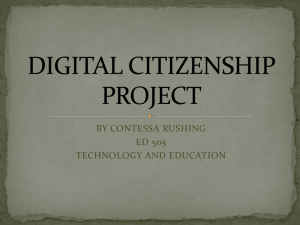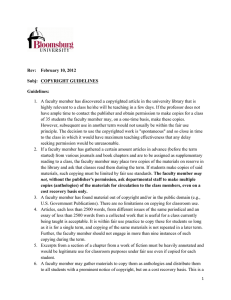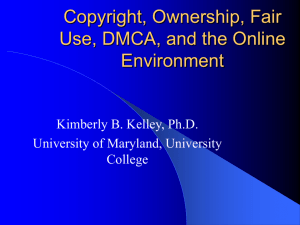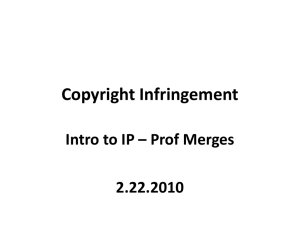CONCORDIA UNIVERSITY COPYRIGHT GUIDELINES 1. Purpose
advertisement
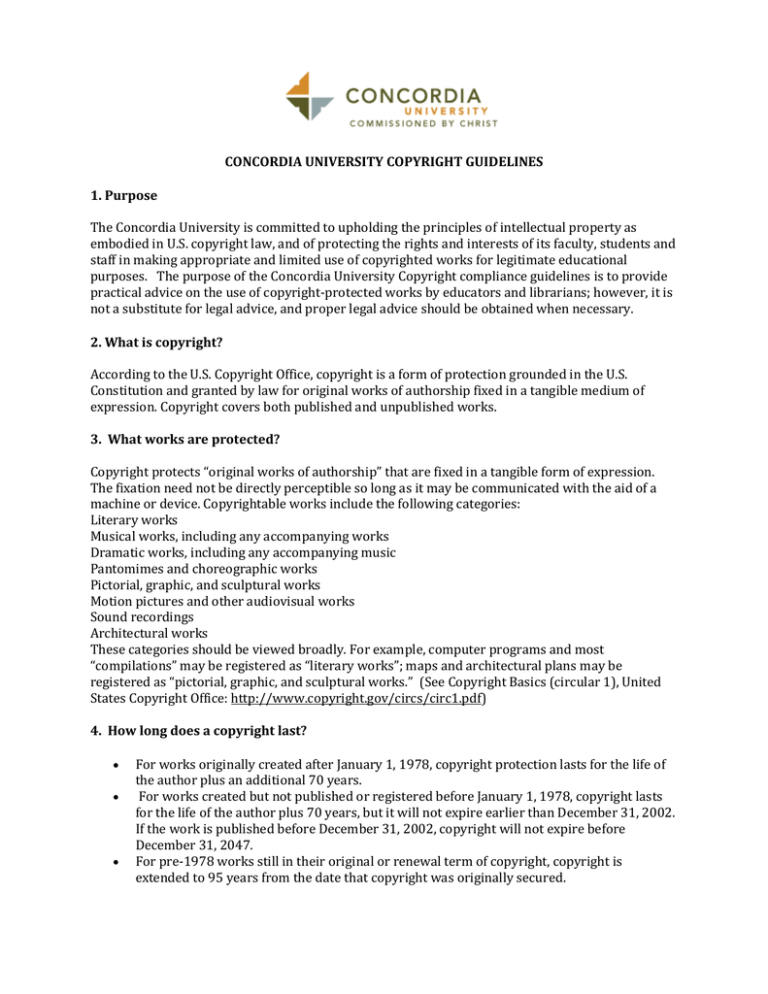
CONCORDIA UNIVERSITY COPYRIGHT GUIDELINES 1. Purpose The Concordia University is committed to upholding the principles of intellectual property as embodied in U.S. copyright law, and of protecting the rights and interests of its faculty, students and staff in making appropriate and limited use of copyrighted works for legitimate educational purposes. The purpose of the Concordia University Copyright compliance guidelines is to provide practical advice on the use of copyright-protected works by educators and librarians; however, it is not a substitute for legal advice, and proper legal advice should be obtained when necessary. 2. What is copyright? According to the U.S. Copyright Office, copyright is a form of protection grounded in the U.S. Constitution and granted by law for original works of authorship fixed in a tangible medium of expression. Copyright covers both published and unpublished works. 3. What works are protected? Copyright protects “original works of authorship” that are fixed in a tangible form of expression. The fixation need not be directly perceptible so long as it may be communicated with the aid of a machine or device. Copyrightable works include the following categories: Literary works Musical works, including any accompanying works Dramatic works, including any accompanying music Pantomimes and choreographic works Pictorial, graphic, and sculptural works Motion pictures and other audiovisual works Sound recordings Architectural works These categories should be viewed broadly. For example, computer programs and most “compilations” may be registered as “literary works”; maps and architectural plans may be registered as “pictorial, graphic, and sculptural works.” (See Copyright Basics (circular 1), United States Copyright Office: http://www.copyright.gov/circs/circ1.pdf) 4. How long does a copyright last? • • • For works originally created after January 1, 1978, copyright protection lasts for the life of the author plus an additional 70 years. For works created but not published or registered before January 1, 1978, copyright lasts for the life of the author plus 70 years, but it will not expire earlier than December 31, 2002. If the work is published before December 31, 2002, copyright will not expire before December 31, 2047. For pre-1978 works still in their original or renewal term of copyright, copyright is extended to 95 years from the date that copyright was originally secured. • All works published before 1923 and all works published from 1923 through 1963 for which no renewal was filed are in public domain. (see Duration of Copyright Protection , American Library Association (ALA): http://www.ala.org/ala/issuesadvocacy/copyright/copyrightarticle/durationcopyright.cfm 5. What is not protected by copyright? Several categories of material are generally not eligible for federal copyright protection. These include among others: • Works that have not been fixed in a tangible form of expression (for example, choreographic works that have not been notated or recorded, or improvisational speeches or performances that have not been written or recorded). • Titles, names, short phrases, and slogans; familiar symbols or designs; mere variations of typographic ornamentation, lettering, or coloring; mere listings of ingredients or contents. • Ideas, procedures, methods, systems, processes, concepts, principles, discoveries, or devices, as distinguished from a description, explanation, or illustration. • Works consisting entirely of information that is common property and containing no original authorship (for example: standard calendars, height and weight charts, tape measures and rulers, and lists or tables taken from public documents or other common sources). (See Copyright Basics (circular 1), United States Copyright Office: http://www.copyright.gov/circs/circ1.pdf) 6. What is “fair use “? Under the “fair use” provision (Section 107 of Copyright Act), a reproduction of someone else's copyright-protected work is likely to be considered fair if it is used for one of the following purposes: criticism, comment, news reporting, teaching, scholarship and research. If the reproduction is for one of these purposes, a determination as to whether the reproduction is “fair use” must be made based upon four factors: a. The purpose and character of use (Transformative Factor) The main point of this factor is whether the material has been used to help create something new, or copied verbatim into another work and whether the use is of commercial nature or is for nonprofit educational purposes. b. The nature of the copyright-protected work The use of published works dealing with facts, news, or reports can be allowed under provisions of “fair use” more readily than works of a creative or imaginative nature (such as poems, novels, or visual art). c. The amount and substantiality of the portion used Generally, the larger the portion of the copyrighted material that is taken and used, the lower the likelihood that the use will constitute a “fair use”. However, even if you take a small portion of a work, your copying will not be a fair use if the portion taken is an essential part of the work or the “heart of the work.” d. The Effect of the Use Upon the Potential Market “Fair use” is more difficult to establish if your use deprives the copyright owner of income or takes away from a new or future market for the copyrighted work. This is true even if your use of the work is not directly competing with his own use of his work; your use may be different but still diminish interest in the copyright owner’s original use of the work. In general, ask yourself: Could my use of this copyrighted work potentially affect the sales of this work? If so, it’s likely not a “fair use”. “Fair use” is an ambiguous concept and the law does not contain any rigid or clearly defined criteria that could be applied to every situation. The above guidelines and analysis of the four factors of “fair use” are for the sole purpose of assisting the CUI community in making the right decision, but do not in any way substitute for professional legal advice. When in doubt about whether your intended use of a copyrighted work is permissible under the provisions of “fair use”, please seek the permission of the copyright owner of the work. 7. Guidelines for classroom copying Agreement On Guidelines For Classroom Copying In Not-For-Profit Educational Institutions With Respect To Books And Periodicals The purpose of the following guidelines is to state the minimum and not the maximum standards of educational “fair use” under Section 107 of H.R. 2223. The parties agree that the conditions determining the extent of permissible copying for educational purposes may change in the future; that certain types of copying permitted under these guidelines may not be permissible in the future; and conversely that in the future other types of copying not permitted under these guidelines may be permissible under revised guidelines. Moreover, the following statement of guidelines is not intended to limit the types of copying permitted under the standards of “fair use” under judicial decision and which are stated in Section 107 of the Copyright Revision Bill (this section). There may be instances in which copying which does not fall within the guidelines stated below may nonetheless be permitted under the criteria of “fair use”. Guidelines I. Single Copying for Teachers A single copy may be made of any of the following by or for a teacher at his or her individual request for his or her scholarly research or use in teaching or preparation to teach a class: • • • • A chapter from a book; An article from a periodical or newspaper; A short story, short essay or short poem, whether or not from a collective work; A chart, graph, diagram, drawing, cartoon or picture from a book, periodical, or newspaper; II. Multiple Copies for Classroom Use Multiple copies (not to exceed in any event more than one copy per pupil in a course) may be made by or for the teacher giving the course for classroom use or discussion; provided that: 1. The copying meets the tests of brevity and spontaneity as defined below; and 2. Meets the cumulative effect test as defined below; and, 3. Each copy includes a notice of copyright. Definitions: Brevity (i) Poetry A complete poem if less than 250 words and if printed on not more than two pages or, from a longer poem, an excerpt of not more than 250 words. (ii) Prose Either a complete article, story or essay of less than 2,500 words, or an excerpt from any prose work of not more than 1,000 words or 10% of the work, whichever is less, but in any event a minimum of 500 words. [Each of the numerical limits stated in "i" and "ii" above may be expanded to permit the completion of an unfinished line of a poem or of an unfinished prose paragraph.] (iii) Illustration One chart, graph, diagram, drawing, cartoon or picture per book or per periodical issue. (iv) "Special" works Certain works in poetry, prose or in "poetic prose" which often combine language with illustrations and which are intended sometimes for children and at other times for a more general audience fall short of 2,500 words in their entirety. Paragraph "ii" above notwithstanding such "special works" may not be reproduced in their entirety; however, an excerpt comprising not more than two of the published pages of such special work and containing not more than 10% of the words found in the text thereof, may be reproduced. Spontaneity (i) The copying is at the instance and inspiration of the individual teacher, and (ii) The inspiration and decision to use the work and the moment of its use for maximum teaching effectiveness are so close in time that it would be unreasonable to expect a timely reply to a request for permission. Cumulative Effect (i) The copying of the material is for only one course in the school in which the copies are made. (ii) Not more than one short poem, article, story, essay or two excerpts may be copied from the same author, nor more than three from the same collective work or periodical volume during one class term. (iii) There shall not be more than nine instances of such multiple copying for one course during one class term. [The limitations stated in "ii" and "iii" above shall not apply to current news periodicals and newspapers and current news sections of other periodicals.] III. Prohibitions as to I and II Above Notwithstanding any of the above, the following shall be prohibited: 1. Copying shall not be used to create or to replace or substitute for anthologies, compilations or collective works. Such replacement or substitution may occur whether copies of various works or excerpts therefrom are accumulated or reproduced and used separately. 2. There shall be no copying of or from works intended to be "consumable" in the course of study or of teaching. These include workbooks, exercises, standardized tests and test booklets and answer sheets and like consumable material. 3. Copying shall not: (a) substitute for the purchase of books, publishers' reprints or periodicals; (b) be directed by higher authority; (c) be repeated with respect to the same item by the same teacher from term to term. 4. No charge shall be made to the student beyond the actual cost of the photocopying. (See Reproduction of Copyrighted Works by Educators and Librarians Basics (circular 21), United States Copyright Office: http://www.copyright.gov/circs/circ21.pdf) 8. Guidelines for educational uses of music The purpose of the following guidelines is to state the minimum and not the maximum standards of educational “fair use” under Section 107 of H.R. 2223. The parties agree that the conditions determining the extent of permissible copying for educational purposes may change in the future; that certain types of copying permitted under these guidelines may not be permissible in the future, and conversely that in the future other types of copying not permitted under these guidelines may be permissible under revised guidelines. Moreover, the following statement of guidelines is not intended to limit the types of copying permitted under the standards of “fair use” under judicial decision and which are stated in Section 107 of the Copyright Revision Bill. There may be instances in which copying which does not fall within the guidelines stated below may nonetheless be permitted under the criteria of “fair use”. A. Permissible Uses 1. Emergency copying to replace purchased copies which for any reason are not available for an imminent performance provided purchased replacement copies shall be substituted in due course. 2. (a) For academic purposes other than performance, multiple copies of excerpts of works may be made, provided that the excerpts do not comprise a part of the whole which would constitute a performable unit such as a section, movement or aria, but in no case more than 10% of the whole work. The number of copies shall not exceed one copy per pupil. (b) For academic purposes other than performance, a single copy of an entire performable unit (section, movement, aria, etc.) that is, (1) confirmed by the copyright proprietor to be out of print or (2) unavailable except in a larger work, may be made by or for a teacher solely for the purpose of his or her scholarly research or in preparation to teach a class. 3. Printed copies which have been purchased may be edited or simplified provided that the fundamental character of the work is not distorted or the lyrics, if any, altered or lyrics added if none exist. 4. A single copy of recordings of performances by students may be made for evaluation or rehearsal purposes and may be retained by the educational institution or individual teacher. 5. A single copy of a sound recording (such as a tape, disc, or cassette) of copyrighted music may be made from sound recordings owned by an educational institution or an individual teacher for the purpose of constructing aural exercises or examinations and may be retained by the educational institution or individual teacher. (This pertains only to the copyright of the music itself and not to any copyright which may exist in the sound recording.) B. Prohibitions 1. Copying to create or replace or substitute for anthologies, compilations or collective works. 2. Copying of or from works intended to be "consumable" in the course of study or of teaching such as workbooks, exercises, standardized tests and answer sheets and like material. 3. Copying for the purpose of performance, except as in A(1) above. 4. Copying for the purpose of substituting for the purchase of music, except as in A(1) and A(2) above. 5. Copying without inclusion of the copyright notice which appears on the printed copy. (See Reproduction of Copyrighted Works by Educators and Librarians Basics (circular 21), United States Copyright Office: http://www.copyright.gov/circs/circ21.pdf) 9. Guidelines for classroom use of videos Classroom use of a copyrighted video is permissible only when all of the following conditions are met: • • • • • • • The performance must be by instructors or by pupils. The performance is in connection with face-to-face teaching activities. The entire audience is involved in the teaching activity. The entire audience is in the same room or same general area. The teaching activities are conducted by a non-profit education institution. The performance takes place in a classroom or similar place devoted to instruction. The person responsible for the performance has no reason to believe that the videotape was unlawfully made. (See Video and Copyright by American Library Association (ALA): http://www.ala.org/Template.cfm?Section=Library_Fact_Sheets&Template=/ContentManagement /ContentDisplay.cfm&ContentID=24635) Recent Changes Regarding Videos Section 1201 of the Copyright Law requires that every 3 years, the Librarian of Congress determines whether any new types of works should become exempt from statutes prohibiting circumvention of technology that prohibits access to encrypted information. In July 2010, the Librarian of Congress added the following exception to the above statute: • Motion pictures on DVDs that are lawfully made and acquired and that are protected by the Content Scrambling System when circumvention is accomplished solely in order to accomplish the incorporation of short portions of motion pictures into new works for the purpose of criticism or comment, and where the person engaging in circumvention believes and has reasonable grounds for believing that circumvention is necessary to fulfill the purpose of the use in the following instances: 1. Educational uses by college and university professors and by college and university film and media studies students. 2. Documentary filmmaking 3. Noncommercial videos 10. Copyright guidelines for distance learning In 2002, the Technology, Education and Copyright Harmonization (TEACH) Act became law and expanded the latitude universities, including CUI, have for the performance and display of copyright-protected materials in a distance education environment, including through the use of Course Management Systems (CMS). The copyright requirements for TEACH and CMS postings are similar to those of classroom handouts, but extend the traditional rules for those handouts to the digital transmission of materials to distance education students. The text of TEACH Act can be found in its entirety at United States Copyright Office web site: http://www.copyright.gov/legislation/pl107-273.html#13301. Below is a list of the primary requirements: • • • • • • • • The teaching must occur at an accredited, nonprofit educational institution. Access must be limited to students currently enrolled in the class and for the time period necessary to complete the class session. Only lawfully made and acquired copies may be used. The use of the copyrighted resources must be within the confines of “mediated instructional activities” integral to the course and under the direction of the course instructor. Use is limited to entire performances of non-dramatic literary and musical work such as poetry or short story reading. Only “reasonable and limited” portions of dramatic literary and musical works (including audiovisual works) must be used unless the entire work is essential to the course. The institution must have a copyright policy and Students must be informed that course content may be protected by copyright law and include a copyright notice on the online material whenever possible. The TEACH doesn’t extend to electronic reserves, Interlibrary loan (ILL), coursepacks, textbooks and conversion of materials from analog to digital formats (except when digital format of the work is unavailable or protected by technological measures), materials specifically marketed for online uses and similar materials typically purchased individually by the students. Finally, appropriate technological protection measures must be used to reasonably limit unauthorized storage and distribution of the copyrighted materials. This may include password protection, content timeout, disabling print and cut-and-paste functions, and IP address authentication, etc. 11. Copyright guidelines for the Library Reserve collection The copying of material to be placed on reserve is subject to the same rules and guidelines of U.S. Copyright Law, especially those concerning “fair use”. Therefore, faculty should exercise judgment in photocopying only enough material deemed necessary for the instructional purpose of the course. The course instructor is liable for any infringement of copyright law committed as a result of photocopying copyrighted works, if the amount photocopied is deemed to be excessive. Books • • • • Books owned by the library or personal copies may be placed in the Reserves collection upon the request of the instructor. During the semester a total of two chapters or 20% of any one work owned by the CU Library may be made available as long as only one chapter or 10% of an item is available at one time. The Library will not accept photocopies of entire books unless they are in the public domain or the faculty member has obtained permission to copy. Books borrowed from another library or via an interlibrary loan request will not be placed on reserve. Journal Articles • One article per issue of a journal can be copied, or more than one, if on the same specific topic, except articles accessed from electronic journal databases. • All copies must include a notice of copyright "The copyright law of the United States (Title 17, United States Code) governs the making of photocopies or other reproductions of copyrighted materials. Users may be liable for copyright infringement.” and a full bibliographic reference (author, title, journal title or book publisher, and date). • The number of photocopied items reserved for any one course will be limited by “fair use” standards. Only one copy of photocopied material is allowed for every 15 students enrolled in a class. • The Library will not retain copied materials longer than one semester. • The copied material will not be used for more than one course. Videos, DVDs and Sound Recordings • All audiovisual Items placed on Reserve must either be owned by the Library or be purchased or legally reproduced personal copies. The library will not accept homerecorded, “off-air” tapes of broadcast programs or burned DVDs without adequate copyright permissions. • Videos, DVDs and sound recordings produced by the instructor or Concordia University may be placed on reserve. Audiovisual works produced by students will need written permission from the students. Homework, Course Notes, and Coursepacks • Homework must have written permission from the student author. • Photocopies from consumable works such as workbooks, exercises, standardized tests, test booklets and answer sheets will not be placed on reserve. • Course packets will not be accepted without necessary permission. Additional items that do not require copyright permission include: • A short story, essay or short poem. • A chart, graph, diagram, drawing, cartoon or picture from a book, periodical or newspaper. The CUI library will remove all items from its reserves list after the end of the semester. Faculty members who would like to keep their material for more than one semester must notify the library of their special instructional needs. 12. Copyright guidelines for Interlibrary loan (ILL) The CUI library will meet Inter-Library Loan requests without obtaining permission from copyright owners provided that the "aggregate quantities" of articles or items received by the patron do not substitute for a periodical subscription or purchase of a work. The Library follows the National Commission on New Technological Uses of Copyrighted Works (CONTU) guidelines for defining "aggregate quantities." The CONTU guidelines permit a library to receive in a calendar year five articles from the most recent five years of a specific journal or periodical. CONTU does not give any guidance to libraries for copying material older than five years. For more information visit Coalition for Networked Information (CNI) web site at: http://www.cni.org/docs/infopols/CONTU.html. 13. Copyright and foreign works The U.S. is a member of the leading international copyright treaty, the Berne Convention. As such, when CUI uses a copyright-protected work from another country, the protections provided to works by U.S. copyright law automatically apply to the use of that work as well (assuming the use takes place in the U.S.). The Copyright Clearance Center has many reciprocal licenses to allow use of materials from other countries. 14. How to obtain copyright permission Permission to use copyright-protected materials, when required, should be obtained prior to using those materials. It is best to obtain permission in writing (including e-mail). Once you have identified the materials you want to use and determined that copyright permission is required, you must locate the copyright holder. If the copyright holder is not listed on the work, locating the appropriate person or entity to grant permission may take some investigative and creative work. The Copyright Office of the Library of Congress (www.loc.gov) may be of assistance in locating a copyright owner if the work is registered. Note, however, that copyright is automatically granted to all works upon their being written down and that registration with the Copyright Office is not required. There are two primary options for obtaining permission to use the work. You may contact the copyright holder directly or you may contact the Copyright Clearance Center. Check with your department manager to determine if Concordia University already has an established process for obtaining copyright permission through the Copyright Clearance Center. If your department or campus does not have a centralized location or process for obtaining copyright permission, you may create an account with the Copyright Clearance Center at www.copyright.com. `The copyright holder or its agent will require the following information in order to provide you with permission: • • • • • • • • • Title of the material Creator/author of the material Publisher of the material Description of material ISBN or ISSN, if applicable Date of publication, if applicable Purpose for which you wish to reproduce the item (research, commercial, educational, etc.) How the material is to be reproduced (e.g., photocopied, digitized) Where the reproduced material will be used or will appear and for how long Bibliography Ashley, C. L. (2004). The TEACH Act: Higher education challenged for compliance. Retrieved June 15, 2010 from EDUCAUSE: http://net.educause.edu/ir/library/pdf/erb0413.pdf Bruwelheide, J. H. (1995). The copyright primer for librarians and educators. Chicago: American Library Association. CONTU (National Commission on New Technological Uses of Copyright Works). (2002). Retrieved June 15, 2010 from Coalition for Networked Information (CNI): http://www.cni.org/docs/infopols/contu.html. Copyright. (2010). Retrieved June 15, 2010 from American Library Association (ALA): http://www.ala.org/ala/issuesadvocacy/copyright/index.cfm. Copyright. (2010). Retrieved June 15, 2010 from U.S. Copyright Office: http://www.copyright.gov/. Copyright and fair use. (2010). Retrieved June 15, 2010 from Stanford University Libraries and Academic Information Resources, Justia, NOLO, LibraryLaw.com & Onecle. Hug the Pug!, Stanford University Libraries: http://fairuse.stanford.edu/index.html. Copyright Central. (2010). Retrieved June 15, 2010 from Copyright Clearance Center: http://www.copyright.com/viewpage.do?pagecode=cr2-n. Crews, K. D. (1993). Copyright, fair use the challenge for universities. Chicago: The University of Chicago Press. Russell, C. (Ed.). (2004). Complete copyright: An everyday guide for librarians. Chicago: American Library Association (ALA). Yu, P. K. (Ed.). (2007). Intellectual property and information wealth: issues and Practices in digital age. (Vol. Volume 1: Copyright and related rights). Westport, CT06881: Praeger publishers.
